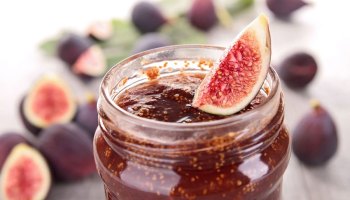Figs - One of the Souths Greatest Summer Treats
TEXARKANA, Ark. –
Figs are not one of those fruits I wanted to try when I was younger. Let’s face it, they just look weird. But once I tried them, I was hooked. Now I look for them at the Gateway Farmers Market every year. If you have been intimidated by the look of fresh figs and have only had them in the cookie form, I challenge you to buy some at the market, or from a friend and give them a try.
The seeds are actually the fruit in figs, but we eat all of it with the exception of the stem. As much as I love fresh fruit, I might have to say fresh figs are one of the south’s greatest summer treats. They are so sweet. The delicacies can be a challenge to find fig fruits for sale, but check out your farmer’s markets, neighbors trees and farm stands. The challenge arise because figs do not store well and have a shelf life of only a few days at best.
The best way to assure that you get fresh figs every season is to plant a fig bush. Luckily, figs thrive in our region and are one of the easiest fruits to grow organically. Since figs do not require cross-pollination you do not have to plant more than one variety. Within a few years, a single bush should be able to supply plenty of fresh fruit for yourself and possibly to share.
Lucky for fig lovers, Figs are fat, sodium, and cholesterol-free. They are an excellent source of dietary fiber. Just one serving, dried or fresh provide 5 grams of dietary fiber or 20 percent of the Daily Value. That same one serving also adds 6 percent iron, 6 percent calcium, and 7 percent of the Daily Value for potassium.
One serving, approximately 3 to 5 dried or fresh figs, provides 3.5 grams insoluble fiber and 1.5 grams water-soluble fiber. Research shows that when adequate dietary fiber is part of an overall healthy diet, it helps maintain healthy cholesterol levels and supports heart, digestive and colon health. A good diet is considered to play an important role in coronary heart disease and cancer prevention. For example, diets rich in soluble and insoluble fibers, help maintain healthy blood cholesterol levels and may lower colon cancer risk.
Fresh figs should be eaten immediately or refrigerated for up to two days. Since figs release ethylene, which can spoil some produce, they should be stored away from produce including bananas, broccoli, brussels sprouts, cabbage, carrots, cauliflower, cucumbers, eggplant, lettuce and other leafy greens, parsley, peas, peppers, squash, sweet potatoes, and watermelon.
If you have an abundance of figs and want to freeze them, it really is quite easy. Start with fully ripe fruit, wash and peel if desired. Decide if you want to make a syrup pack or dry pack.
If wanting a syrup pack, it is recommended to make a heavy syrup for figs. To make the syrup, dissolve two and three fourths sugar in 4 cups lukewarm water, mixing until the solution is clear. This will yield five and one third cups syrup. Chill syrup before using.
Use just enough cold syrup to cover the prepared fruit after it has been placed in the container (about one half to two thirds cup of syrup per pint). Add three fourth teaspoon (2250 mg) ascorbic acid or one half cup lemon juice to each quart of syrup. Pack figs into freezer containers and cover with cold syrup, leaving headspace. Seal and freeze.
If you choose to dry pack, meaning not packing them in syrup, dissolve three fourth teaspoon (2250 mg) of ascorbic acid in 3 tablespoons cold water and sprinkle over 1 quart of fruit. This will prevent darkening of light colored figs. Pack figs into containers, leaving headspace. Figs can also be frozen first on a tray and then packed into containers as soon as they are frozen. Seal containers, date and freeze.
For more information on the preservation of figs, canning, freezing or drying, contact the Miller County Extension Office, 870-779-3609 or visit us in room 215 at the Miller County Courthouse. We're online at cdue@uada.edu, on Facebook at UAEXMillerCountyFCS, on Twitter @MillerCountyFCS or on the web at uaex.uada.edu/Miller.
This recipe for Strawberry-Fig Preserves is sure to be a family favorite. Such a great treat on a hot buttered biscuit.
Strawberry-Fig Preserves
3 cups mashed figs
2 packages (3 oz. each) strawberry gelatin
3 cups sugar
Sterilize canning jars. Wash, peel, and mash figs. Place figs, gelatin, and sugar in large pan and bring to a boil. Lower heat and continue to boil 3 to 5 minutes, stirring often. Pour hot preserves into hot jars, leaving ¼ inch headspace. Wipe rims of jars with a dampened clean paper towel; adjust two-piece metal canning lids. Process in a Boiling Water Canner. For 10 minutes. Yield: About 6 half-pint jars.
By Carla Due
County Extension Agent - FCS
The Cooperative Extension Service
U of A System Division of Agriculture
Media Contact: Carla Due
County Extension Agent - FCS
U of A Division of Agriculture
Cooperative Extension Service
400 Laurel Street, Suite 215 Texarkana AR 71854
(870) 779-3609
cdue@uada.edu
Related Links
The Arkansas Cooperative Extension Service is an equal opportunity institution. If
you require a reasonable accommodation to participate or need materials in another
format, please contact your County Extension office (or other appropriate office)
as soon as possible. Dial 711 for Arkansas Relay.
Pursuant to 7 CFR § 15.3, the University of Arkansas System Division of Agriculture
offers all its Extension and Research programs and services (including employment)
without regard to race, color, sex, national origin, religion, age, disability, marital
or veteran status, genetic information, sexual preference, pregnancy or any other
legally protected status, and is an equal opportunity institution.
